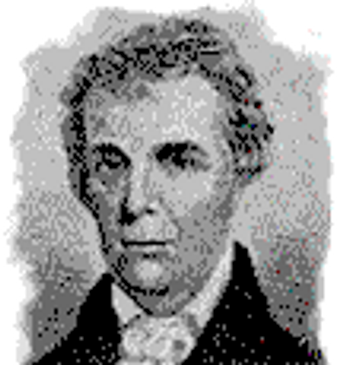History
The Christian Church (Disciples of Christ) is a Protestant denomination of approximately 800,000 members in the United States and Canada. It's one of the largest faith groups founded on American soil.
Some key persons in the church

Presbyterian minister Barton W. Stone was born in Port Tobacco, Maryland, December 24, 1772. He died in Hannibal Missouri, November 9, 1844. Stone was educated as a school teacher and entered the ministry through the presbyterian Church. He served a church in Cane Ridge Kentucky, and after hosting the historic Cane Ridge Revival o
Presbyterian minister Barton W. Stone was born in Port Tobacco, Maryland, December 24, 1772. He died in Hannibal Missouri, November 9, 1844. Stone was educated as a school teacher and entered the ministry through the presbyterian Church. He served a church in Cane Ridge Kentucky, and after hosting the historic Cane Ridge Revival of 1801, (also see pages on the Cane Ridge Meeting House and Shrine) he and several others formed the Springfield Presbytery denouncing all human creeds and appealing to the Bible as the only rule of faith and practice.
They soon dissolved the Springfield Presbytery, and published the Last Will and Testament of the Springfield Presbytery, one of the documents the Christian Church (Disciples of Christ) considers key in its development. They dissolved their denominational ties to enter into unity with "the body of Christ at large." They called themselves, simply, "Christians."

Thomas Campbell was born in County Down, Ireland, February 1, 1763. He died in Bethany, Virginia (now West Virginia), January 4, 1854. He came to America from Scotland in 1807. He was chastised by Pennsylvania church authorities for refusing to use Presbyterian creeds as terms of communion. In 1808 he and others founded the Christia
Thomas Campbell was born in County Down, Ireland, February 1, 1763. He died in Bethany, Virginia (now West Virginia), January 4, 1854. He came to America from Scotland in 1807. He was chastised by Pennsylvania church authorities for refusing to use Presbyterian creeds as terms of communion. In 1808 he and others founded the Christian Association of Washington, Pennsylvania. That group adopted the motto, well-known by Disciples, "Where the scriptures speak, we speak; where the Scriptures are silent, we are silent." Campbell and others were called "Reformers," for their desire to restore the Church's first century roots. This way of life came to be known as the "Restoration Movement."
Near Washington, Pennsylvania, Campbell and his son, Alexander, and the Christian Association established the Brush Run Church, which, in 1815, became part of a nearby Baptist Association.
Reformers and the Baptists differed on key issues. By 1830, the Reformers cut their last ties with the Baptist Association and became known as "Disciples."
Thomas Campbell's passion for Christian unity is summed up in his proclamation that : "The church of Christ upon earth is essentially, intentionally, and constitutionally one." This statement is the first and key proposition of Thomas Campbell's Declaration and Address, a work called by some the "Magna Charta" of the movement that preceded the denomination known as the Christian Church (Disciples of Christ).

Alexander Campbell was born September 12, 1788 in the County of Antrim, Ireland. He was raised as a Presbyterian. He attended the University of Glasgow, Scotland.
In 1809, Alexander arrived in America from Scotland, and joined his father, Thomas, in western Pennsylvania. He carefully read and fully endorsed the principles of Thomas
Alexander Campbell was born September 12, 1788 in the County of Antrim, Ireland. He was raised as a Presbyterian. He attended the University of Glasgow, Scotland.
In 1809, Alexander arrived in America from Scotland, and joined his father, Thomas, in western Pennsylvania. He carefully read and fully endorsed the principles of Thomas' Declaration and Address. Biographer Nathaniel Haynes says that Thomas and Alexander Campbell were "one in their aims, spirit and work."
The younger Campbell was a prolific writer. In 1823, he founded the periodical The Christian Baptist. After the Reformers dissolved ties with the Baptists, Campbell founded a new publication called The Millennial Harbinger. He was a talented debater, and in 1829 drew attention to the Restoration Movement in a widely known debate with social reformer Robert Owen. In 1837, he engaged the Roman Catholic John B. Purcell, archbishop of Cincinnati, in a widely publicized eight day debate on the traditions and beliefs of the Catholic Church.
His public speaking skills, writing, and articulation of the place of reason (but not pure rationalism) in Christian faith propelled him into the leadership of the "Disciples of Christ."
A dedicated scholar and educator, Alexander Campbell founded Bethany College, Bethany, Virginia (now West Virginia) in 1840 and served as the school's first president.
Some key dates
1832-
1832-1968
1832-1968
The "Christians" and the "Disciples of Christ" agreed on basic beliefs and aims and united with a formal handshake in Lexington, Kentucky, and created a new Christian movement on the American frontier.
1832-1968
1832-1968
1832-1968
The "Christians" and the "Disciples of Christ" functioned and grew as a "movement," often referred to as the "Stone-Campbell movement." During this period, Disciples often described the relationship of the Christians and the Disciples of Christ as a "brotherhood." In 1960, the Commission on Brotherhood Restructure started the task of designing a new form of organization. Throughout the 20th century, American Asian, Hispanic and African American Disciples congregations multiplied.
1968-
1832-1968
1968-
A representative assembly meeting in Kansas City overwhelmingly approved the Provisional Design for the Christian Church (Disciples of Christ). Church historian D. Duane Cummins writes: "Approval of the Provisional Design marked the passage of the Disciples into denominational maturity. Officially named the Christian Church (Disciples of Christ), they became a church."